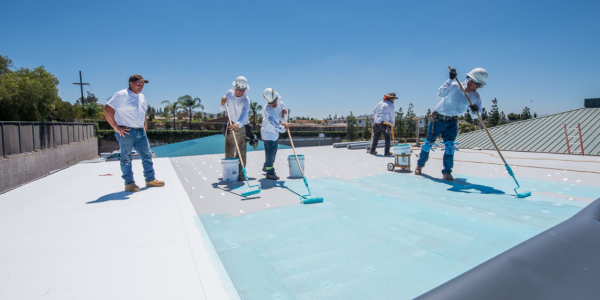What Are the Best Adhesives for Commercial Roofs?

By Johns Manville.
A breakdown of which adhesives are the best for TPO, EPDM and PVC roofing systems.
Adhesives are one of the best ways to keep low-slope roofing systems secure. They offer durability as well as a smooth, aesthetically pleasing look. They also do not require penetration which allows for easier installation and less of a risk of thermal bridging.
The range of available products has grown significantly in recent years, making adhesives one of the most versatile bonding strategies available today.
While there are many solutions for adhering commercial roofing systems, it’s important to choose the right product for the application. The following is an informational guide for selecting the best adhesive based upon the roofing type, application, environmental conditions and other factors.
Adhesive types
There are a variety of adhesive formulations and methods of application. Adhesive types include:
- Solvents – For TPO and EPDM roofs, the two-sided application is synthetic polymer-based
- Low VOC – For TPO, EPDM and PVC roofs, also a two-sided application and synthetic polymer-based
- Self-adhered – For TPO membranes, one-sided, pre-applied factory release liner
- Water-based – One-sided for TPO, EPDM and PVC, and two-sided for vertical applications
- Single-component canister low VOC options – For TPO, EPDM and PVC, two-sided, low VOC aerosol
- Two-component foam – One-sided application for fleece-backed membranes
Insulation/coverboards
Urethane adhesives continue to grow in popularity. These adhesives offer a consistent cure time, independent of the temperature and humidity. Made from polyurethane and odor-free, they are ideal for healthcare and educational facilities looking to avoid odors. Urethane adhesives have a variety of packaging options — including cartridges, boxes and drums — offering versatility for contractors’ specific project needs. No primers or catalysts are required for application. Johns Manville’s RSUA can be used on both membrane and insulation situations, while the JM Two-Part Urethane Insulation Adhesive can be used solely for insulation attachment.
JM’s One Step Foamable Adhesive is a two-component, no-odor polyurethane product for fleece-backed membranes. It can be utilized under a wide range of temperatures. The typical flash/drying time is 3 to 6 minutes, and faster during the hot summer months, which requires more monitoring.
Bituminous systems
With bituminous systems, roofing contractors can choose from a number of options. The DynaSet 1K is JM’s newest cold adhesive. It is a one-part, solvent-free, moisture-curing adhesive for synthetic rubber modified bitumen (SBS) membranes and can be used in traditional SBS systems, or as a non-SA SBS vapor barrier adhesive in JM single ply systems. The moisture-cure feature makes it ideal in concrete deck situations. Installed as a full coverage cold adhesive or a gravity-fed ribbon for faster applications, the latter approach allows for venting moisture below an SBS vapor barrier. Solvent and odor-free, with no mixing of components required, the material contains low VOC content.
For bonding modified bitumen membranes and aggregate surfacings, the MBR Cold Application Adhesive is best suited. Offering excellent wind uplift resistance, the one-part, solvent-based product can be used as an alternative to asphalt.
MBR Utility Cement is a one-part, asphalt based, general purpose mastic that can be used for vertical and horizontal flashing applications. The cold process adhesive works across a wide temperature range and is ready to use as shipped. The product cures and forms a durable, elastomeric, and watertight film and offers versatility for stripping in laps or other small repair applications.
Single-ply systems
TPO and EPDM water-based adhesives are the fastest and most cost-effective way to install a roof in the warmer months. This one-part adhesive is compatible with approved insulations and cover boards, and concrete decks. The adhesive has one of the highest coverage rates when compared to most other products on the market, thereby saving contractors money and time. There is also a water-based offering for PVC roofs. These adhesives are typically applied with a nap roller, however, some contractors experience further labor savings when spraying and back rolling the product.
With formulations for TPO, EPDM and PVC as well, the All Seasons Sprayable product is an aerosol bonding adhesive for roofing systems and wall flashings. The low-VOC material comes in a pressurized canister, is suitable for both warm and cold weather applications and cures quickly. Also suitable for vertical walls, the spray application saves time, as compared to roll-on products. This product is applied as a bonding adhesive which means both the substrate and the membrane will receive adhesive and then be married together.
One of JM’s most popular offerings, our Low VOC Membrane Adhesive, is a one-part, synthetic polymer-based adhesive. There is also a low VOC option for PVC roofs. The adhesive should not be used on fleece-backed membranes.
The same restriction applies to the TPO 1168 Membrane Adhesive. This low VOC synthetic polymer-based product is approved for sale and use in California.
Original article source: Johns Manville
Learn more about Johns Manville in their Coffee Shop Directory or visit www.jm.com.




-2025-xtv-mls-tour-2.png)
















Comments
Leave a Reply
Have an account? Login to leave a comment!
Sign In